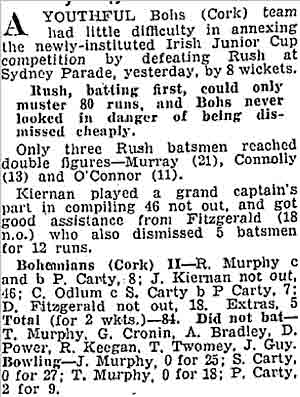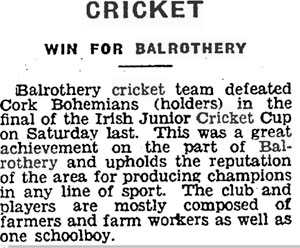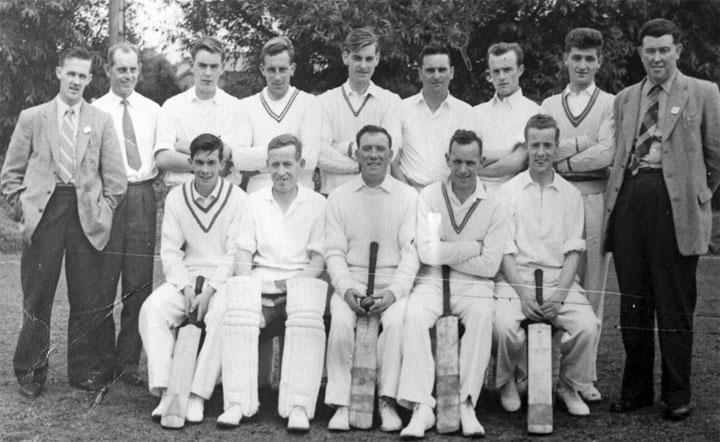The Irish Junior Cup was the brainchild of KP Tanham, a member of Railway Union CC and of the Executive Committee of the Leinster Cricket Union. The concept of a competition for junior cricketers to pit their wits against players from different parts of Ireland was proposed in 1950. It was intended that this competition would provide additional fixtures for teams which were outside the main cricketing strongholds and promote the development of cricket throughout the country.
The competition was never recognised officially by the Irish Cricket Union (ICU) nor by any of its constituent unions, and one consequence of this is that records of the competition are very haphazard. We are dependent mostly on the provincial weekly papers for details of the games if a team from its area was involved, but at an official level, there is a total neglect of this competition. The Cricket Ireland Archive contains no reference to the Irish Junior Cup, and there are no details of this competition on the history section of the Cricket Leinster website.
 Report and Scorecard, Irish Press, 28 September 1950
Report and Scorecard, Irish Press, 28 September 1950
When the concept of an All-Ireland Junior Cup was proposed at a meeting of the ICU in June 1950, the delegate from the NCU indicated that his union could not support the idea because the fixture list was already full. The NWCU adopted a similar position, with the result that the ICU never endorsed the competition, and this is a possible reason for the name of the competition being changed to the Irish Junior Cup. Undaunted, Tanham persevered, and invitations were issued to Limerick CC, Longford CC, Galway CC, the winners of the South-East League, a team from the Munster Cricket Union and the winners of the Intermediate Cup in the LCU. (Initially the qualifying competition in Leinster was the Intermediate Cup, but from the early 1970s onwards, the Middle Cup became the qualifying competition).
Fingal League teams had an affection for the competition because in the first 6 years of its existence, a team from Fingal contested four of the finals. In 1950, Rush lost to Cork Bohemians in the final at Sydney Parade. Rush scored 80 all out, and Bohemians got the score for the loss of 2 wickets. The main contributor for Bohemians was Jim Kiernan (46*), brother of Tom Kiernan, the Irish Rugby International. Among the players for Rush were Tom Murphy (Man-O-War), James O’Connor (father of David, President of Cricket Ireland), and Joe Connolly (father of Joe, the famous umpire).
 Drogheda Independent, 15 September 1951
Drogheda Independent, 15 September 1951
In 1951, Balrothery CC represented the LCU, and beat Galway County in the semi-final. According to The Irish Times, the Galway batting “was all at sea on a wicket at Terenure CYM which was much faster than they are accustomed in the West,” and against the bowling of Mooney (5 for 11) and Russell (4 for 11), they were all out for 32. In the final, Balrothery met Bohemians, Cork, the holders of the trophy, and they were in trouble early on when 5 wickets fell for 11 runs, but Simon Hoare (26) and Hugh Russell (13) retrieved the situation with Balrothery’s innings closing on 63 runs. Excellent bowling by Kit Mooney (4 for 11) and C. Russell (6 for 8) was mainly responsible for the victory, and according to the Irish Times, neither of them “sent down any loose stuff at all, and Bohemians were struggling from the start.” Bohemians were bowled out for 20, with 6 batsmen not scoring a run. The Drogheda Independent in congratulating the Balrothery players on their victory, commented that this victory “upholds the reputation of the area for producing champions in any line of sport. The club and players are mostly composed of farmers and farm workers as well as one schoolboy.”
Balrothery CC was again involved in Irish Junior Cup action in 1954. It defeated Ballyclare, County Antrim in the semi-final, and The Drogheda Independent again drew attention to the fact that the team was comprised of farmers and farm workers who “learned their cricket in their leisure hours on the village green.” In the final, Balrothery was opposed by Cahir Park, Tipperary, and was badly handicapped by a lack of runs. They scored 48 runs with only Simon Hoare (11) and R. Moore (12) getting into double figures. Cahir Park scored the runs for the loss of 6 wickets, with Mooney (3 for 31) and Russell (3 for 25) being the successful bowlers.
The same two clubs contested the final in 1955 at Sydney Parade. On this occasion, Cahir Park batted first, and scored 79 runs. The successful bowlers were Russell (3 for 32), Mooney (3 for 13) and Hoare (4 for 33). Unfortunately, there was another batting collapse with only C. Mooney (13) getting into double figures, and Balrothery lost by 23 runs. Cahir Park created a record because it was the first club to retain the Irish Junior Cup.
 Score Card for 1962 Irish Junior Cup
Score Card for 1962 Irish Junior Cup
Leinster teams were more successful during the 1970s, with wins for Clontarf and Old Belvedere in 1970 and 1971. Limavady beat Clontarf in the 1972 final, and Donemana completed a double of wins with its victories in 1973 and 1974. Fingal interest in the Irish Junior Cup was revived in 1975 by The Hills CC when it beat Greysteel, Derry in the semi-final, and qualified to meet Zingari in the final which was played at the Phoenix Park where The Hills CC scored 200 and in reply, Zingari was bowled out for 68.
The lack of official recognition for the tournament was proving to be a real bone of contention, and in 1977, John Dawson, honorary secretary of the LCU’s junior branch suggested to the ICU that it could improve its image with the junior cricketer by promoting an All-Ireland competition for the junior player. He did not get much satisfaction from the ICU and was advised to take the matter up with his provincial branch first, and to come back with firm proposals for the following year. An Irish Junior Cup competition was held in 1977 with NICC beating Old Belvedere in the final. After 1977, the competition appeared to have evolved into a Leinster versus Munster selection because there are no further references to the Irish Junior Cup from this date onwards even though teams from the MCU area played qualifying games up to 1980.
The question of a cup competition was again the subject of debate at the ICU’s AGM in 1978, and in a report on this matter, the Irish Times suggested that the ICU should do something about the distant image which it holds for junior players. “For them, the ICU is a remote body to whom they annually pay a subscription and get nothing in return”. It was argued at the AGM that “a competition at non-senior level would go a long way towards generating a closer affinity” between junior players and the ICU. Nothing happened in this regard, and Michael Sharp, Secretary of the Junior Branch in succession to John Dawson, indicated that he received a request from the Munster Cricket Union in the early 1980s for a revival of the Leinster versus Munster fixture, but nothing came of the request, and he suggested that fixture congestion may have been a contributing factor.
What did the ICU do? To counter the arguments that it had absolutely no relevance to cricketers who were not involved in representative cricket, it established the Irish Senior Cup (Schweppes) in 1982, a competition for senior clubs, but it continued to be irrelevant as far as junior cricketers were concerned. A list of the winners and runners-up is provided in the Appendix, and a noteworthy element is the number of clubs which are no longer involved in cricket.
Acknowledgements: Thanks to Barry Chambers, Dr E. M. Power, Brian Stirling, Joe Doherty, Fergus Carroll, Martin Russell, Matt Dwyer, John Archer, Michael Sharp for their assistance in the preparation of this article.
Irish Junior Cup Winners and Runners-Up| Winners | Runners-up | |
| 1950 | Cork Bohemians | Rush |
| 1951 | Balrothery | Cork Bohemians |
| 1952 | Longford | Cahir Park |
| 1953 | Galway | Longford |
| 1954 | Cahir Park | Balrothery |
| 1955 | Cahir Park | Balrothery |
| 1956 | Dean Hill | Galway |
| 1957 | LYMPA/ Woodvale (shared) | |
| 1958 | Clontarf 111 | Lismore |
| 1959 | Cloughfern | CI (Limerick) |
| 1960 | Ardmore 11 | Tramore |
| 1961 | Leinster 111/Dunmurry (shared) | |
| 1962 | Ardmore 11 | Tramore |
| 1963 | Tramore | NICC |
| 1964 | Donemana | Leinster |
| 1965 | Ballyspallen | CYM |
| 1966 | Laurelvale | Phoenix |
| 1967 | Queen’s University | Wanderers |
| 1968 | Wanderers (Cork) | Brigade 11 |
| 1969 | Strabane | Clontarf |
| 1970 | Clontarf | Nixon’s (Derry) |
| 1971 | Old Belvedere | Donowen |
| 1972 | Limavady | Clontarf |
| 1973 | Donemana | Old Belvedere |
| 1974 | Donemana | Galway |
| 1975 | The Hills | Zingari |
| 1976 | ||
| 1977 | NICC | Old Belvedere |
| 1978 |
Note from Barry Chambers
 Ardmore CC, Winners of Irish Junior Cup in 1960 and 1962
Ardmore CC, Winners of Irish Junior Cup in 1960 and 1962
A photo of the 1960 Ardmore team that won it and the scorecard from the 1962 final when they beat Tramore for the second time. The number 11 who hit the winning boundary was Johnny Gallagher who was a car mechanic who did my MOT work. Every year when I went to him he would always tell me the story of how he won the Irish Cup for Ardmore. My uncle Eddie opened the batting. Current NW President Connie McAllister and former BBC Radio Foyle presenter Ken McCormack are the only two still living from the 1960 team. Willie Dunlop died last year at the age of 94 - we reckoned he was the oldest NW senior cricketer around that time.
Report on 1965 Final, Ballyspallen v CYM (Sam McGregor)The year we won the Irish Junior Cup was 1965. In the semi-final we travelled to Crossgar and won, Unfortunately I have not a record of the score. The final was played in Dublin against CYM a match which we won, not without a scare or two.
 Ballyspallen CC, Winners of Irish Junior Cup in 1965
Ballyspallen CC, Winners of Irish Junior Cup in 1965
The most memorable part of the match was when off the first ball CYM innings, I caught their opening batsman at first slip off Brian Martin bowling.
Such was the support that we had for the final the club took a double decker bus to Dublin and I remember coming home and stopping in Slane for a refreshment break.
The trophy was a beautiful rose bowl which I have never seen the like of since.
The names in the photograph are as follows starting from left to right
Joe Pigott ( marker) John Crown,Tommy Corscadden,Jack Nicholl,Robin Martin,Jonny Montgomery,Tommy Martin,Gilbert Townley,Walter Pigott. Front Row left/right Billy Rodgers,Victor Townley,Brian Martin,Sam McGregor (captain) Keith Wallace,Roy Wilson.
The Hills v Zingari, Irish Junior Cup, 20 September 1975
As winners of the Middle Cup in 1974, The Hills qualified for the Irish Junior Cup in 1975. In the semi-final, The Hills beat Greysteel from Derry on a score of 137 runs to 59 runs. The final was played at Phoenix against Zingari, the adopted title of Cliftonville 111. This report is based on the recollections of some of the players who were involved in the game, and the first difficulty was to ascertain exactly which players represented The Hills CC on this occasion. After an exhaustive series of interviews, there is a reasonable consensus that The Hills team was as follows, we think:
John Archer, Liam Archer, Paddy Byrne, Martin Byrne, Anthony Byrne, Jimmy Byrne, Seán Hoare, Joe Hoare, Martin Russell, Nick Farrell, Matt Dwyer.
Interview with Martin Russell
The Hills batted first with Johnny Archer and Martin Russell opening the batting. One of the opening bowlers for Zingari, W. Irvine, who later played for Bready, took 2 early wickets. (Liam and John Archer), and The Hills looked to be in serious trouble. However, Nick Farrell joined Martin Russell at the crease, and for some time, it became a question of survival. Zingari then has the misfortune to lose Irvine because he went over on his ankle and was unable to continue bowling. Nick Farrell and Martin Russell accumulated runs steadily, and there were no further alarms. When Nick Farrell was out, Seán Hoare joined the fray and he gave further impetus to the scoring rate. Thus, despite of the early setbacks, The Hills batted the full 50 overs and ended on 200 for 9. In that era, and especially in late season, a score of 200 was almost certainly a winning score, but nothing was taken for granted by this incredibly competitive team. Liam Archer took 3 wickets for 20 runs and Martin Byrne took 3 for 22. Zingari was never in the hunt. It only batted 40 of the 50 allocated overs and it ended on 68 runs. This completed a 4-year period during which The Hills won 12 titles at either league or cup level and won several Championship trophies in the Fingal League.
